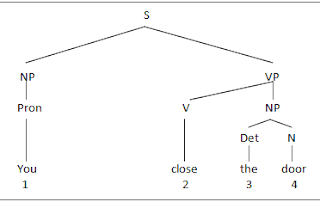One of the most important concepts proposed by Chomsky is the concept of surface and deep structure. The Generativism paradigm claims that the concept of structural analysis proposed by Structuralism paradigm is too swallow, it only reaches the level of surface structure. Surface structure can be defined as the syntactic form they take as actual sentences. In the other words, it is forms of sentences resulted from modification/ transformation. Consider these sentences:
(1) You close the door.
(2) The door is closed by you.
(3) Close the door!
The first sentence is active, second is passive, and the last is imparative. However, if you take a look those closely, you will find that those three are very closely related, even identical. They seem to be identical, since they have the same undelying abstract representation that is called deep structure. It is defined as an abstract level of structural organization in which all the elements determining structural interpretation are represented. If you want to analyze the relation of those three sentences, the first you have to know about the deep structure of them, since deep structure is the input of transformation rules. We cannot apply transformation rules if you don’t have deep structure. transformation rules are sets of rules which will change or move constitiuents in the structures derive from the phrase structure rules.
e.g.
The DS (deep structure)

(2) | SD (structure describtion) : SC (Structural change) : SS (Surface structure) : | 1 2 3 4 3 4 + be 2+en 1 The door is closed by you |
Note: the SC is passive transformation rules | ||
(3) | SD: SC: SS: | 1 2 3 4 0 2 3 4 Close the door! |
Note: 0 is deletion | ||
From the above example, it can be concluded that deep structure then is a pure representation of thematic relations. Anything which is interpreted as the subject or object of a given predicate will be in the subject or object position of that predicate at Deep structure no matter where it is found at Surface structure.
....................................................................
See also:
Transformation Rules
Tree Diagram















0 comments:
Post a Comment